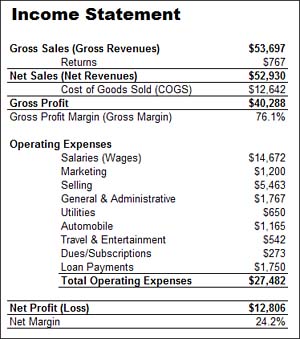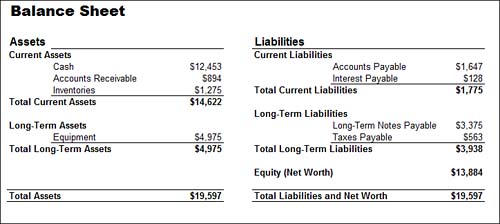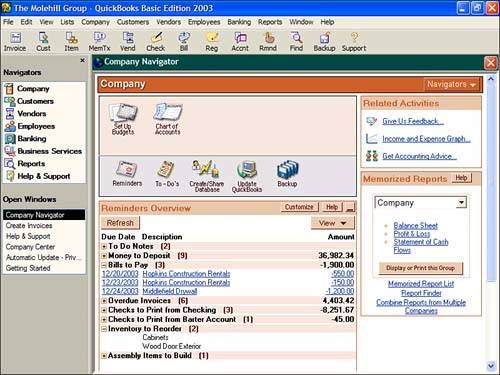| Throwing all your receipts in a shoebox is just a start. To truly track your business's finances, you need to incorporate all the data from those receipts and from your inventory and customer management systems into some sort of an accounting system. This chapter isn't the place to go into all that's involved in setting up a detailed small business accounting system; there are lots of books and online resources that are more appropriate to the task. We can, however, take a look at what you need to track to make your accounting system work. Tracking Your Business Activity All accounting systems track basic types of activities: revenues and expenses . Revenues are the sales you make to your eBay customers. Expenses are the costs you incur in the running of your business ”the inventory you have to purchase, as well as all those other things you need to buy to make your business run. tip  | Want to learn more about setting up a small business accounting system? Then check out Accounting for Everyone (www.accountz.com) or the Accounting section on the BusinessTown.com site (www.businesstown.com). |
In accounting terms, the money you take in creates a credit on your books. The money you spend creates a debit . When your credits exceed your debits, you're making a profit (or at least generating positive cash flow). When your debits exceed your credits, your business is losing money. Obviously, the former position is preferable. To make your accounting system work, you have to enter each and every financial activity of your business. Make a sale, enter it in the books. Buy some supplies , enter that in the books. At regular intervals ”typically at the end of each month ”you add up all the credits and debits (after putting them in the proper slots) and take a snapshot as to how your business is doing. These snapshots are the financial statements you use to measure the financial condition of your business. Key Financial Statements There are two key financial statements that you should prepare at the end of each month. These are the income statement (sometimes called a profit and loss statement , or P/L ) and a balance sheet . These documents measure the condition of your business from two different angles. Income Statement The income statement reflects the revenue your business generates, the expenses you pay, and the profit (or loss) that filters down. This is done by showing your revenues, subtracting the cost of goods sold (which reveals the gross profit), and then subtracting all your operating expenses to show your net profit. As you can see in Figure 6.1, the top of the statement lists all the money your business took in ”your business's revenues. The bottom of the statement lists all the money you paid ”your business's expenses. Subtract the bottom from the top and the number you get, expressed on the last line of the statement, is your business's profit or loss. Figure 6.1. A typical income statement.  Your operating expenses are typically broken out into multiple line items. In addition, you'll see the gross profit and net profit described as percentages of net revenues. (When shown this way, they're called gross margin and net margin .) Here's a brief explanation of the most important line items on the income statement: -
Gross Revenues. This line (also called Gross Sales ) reflects all of your dollar sales for the period, not counting any damaged or returned goods. -
Returns. Sometimes called Returns and Allowances , this line reflects the cost of any returned or damaged merchandise, as well as any allowances and markdowns. -
Net Revenues. Net Revenues (also called Net Sales ) reflect your Gross Revenues less your Returns and Allowances. -
Cost of Goods Sold. This line (also called COGS or Cost of Sales ) reflects the direct costs of the products you sold for the period. -
Gross Profit. This line reflects the direct profit you made from sales during this period. It is calculated by subtracting the Cost of Goods Sold from Net Revenues. -
Gross Margin. This line (also called Gross Profit Margin ) describes your Gross Profit as a percent of your Net Revenues. You calculate this number by dividing Gross Profit by Net Revenues. -
Operating Expenses. This line reflects all the indirect costs of your business. Typical line items within this overall category include Salaries, Advertising, Marketing, Selling, Office, Office Supplies, Rent, Leases, Utilities, Automobile, Travel and Entertainment (T&E), General and Administrative (G&A), Dues and Subscriptions, Licenses and Permits, and Training. Not included in this section are direct product costs (which should be reflected in the Cost of Goods Sold), loan payments, interest on loans, taxes, depreciation, and amortization. -
Net Profit (Loss). This line (also called Net Earnings or Net Income ; the words "income," "earnings," and "profit" are synonymous) reflects your reported profit or loss. You calculate this number by subtracting Operating Expenses from Gross Profit; a loss is notated within parentheses. -
Net Margin. This line describes your Net Profit as a percentage of your Net Sales. You calculate this number by dividing Net Profit by Net Sales.  | In all financial statements, a loss is typically noted by inserting the number in parentheses. So if you see ($200), you note a loss of $200. An alternative, although less accepted, method is to put a negative sign in front of any losses. If you're printing in color , you would use red (in addition to the parentheses) to notate all losses. |
Most businesses will create an income statement for each month in the year, and then a comprehensive income statement at the end of the year. Many businesses like to track their progress over the course of the year, and create a year-to-date income statement at the end of each month, as well. Balance Sheet The other essential financial statement is the balance sheet. The balance sheet looks at your business in a slightly different fashion from an income statement. Instead of looking at pure monetary profit (or loss), the balance sheet measures how much your business is worth. It does this by comparing your assets (the things you own ”including your cash on hand) with your liabilities (the money you owe to others). As you can see in Figure 6.2, the assets go on the left side of the balance sheet, and the liabilities go on the right. The total number for each column should be equal ”hence the "balance" part of the title. You should generate a balance sheet at the end of every month, and at the end of the year. Figure 6.2. A typical balance sheet.  Here's a brief explanation of the most important asset items on the balance sheet: -
Current Assets. This category includes those items that can be converted into cash within the next 12 months. Typical line items would include Cash, Accounts Receivable, Inventories, and Short- Term Investments. -
Fixed Assets. This category (sometimes called Long-Term Assets ) includes assets that are not easily converted into cash, including Land, Buildings, Accumulated Depreciation (as a negative number), Improvements, Equipment, Furniture, and Vehicles -
Long-Term Investments. This category includes any longer-term investments your business has made. -
Total Assets. This line reflects the value of everything your company owns. You calculate this number by adding together Current Assets and Fixed Assets. The following are the key line items on the liabilities side of the balance sheet: -
Current Liabilities. This category includes any debts or monetary obligations payable within the next 12 months. Typical line items would include Accounts Payable, Notes Payable, Interest Payable, and Taxes Payable. -
Long-Term Liabilities. This category includes debts and obligations that are due to be paid over a period exceeding 12 months. Typical line items would include Long-Term Notes Payable and Deferred Taxes.  | To make your balance sheet actually balance, the Total Liabilities and Net Worth number must equal the number for Total Assets. |
-
Equity. This line (sometimes called Net Worth ) reflects the owners ' investment in the business. Depending on the type of ownership, this line may be broken into separate lines reflecting the individual equity positions of multiple partners or the company's capital stock and retained earnings. -
Total Liabilities and Net Worth. This line (sometimes called Total Liabilities and Equity ) reflects the total amount of money due plus the owners' value. You calculate this number by adding together Current Liabilities, Long-Term Liabilities, and Equity. Software for Small Business Accounting How do you put together all your business data and generate these financial statements? You have two practical options: hire an accountant or use an accounting software program. (You could also, I suppose, keep your books by hand, on oversized sheets of ledger paper ”although hardly anyone does it that way anymore, in this computerized day and age.) We'll look at accounting software first. There are many different programs you can use to keep your business's books. The simplest of these programs are the personal financial management programs, such as Microsoft Money and Quicken. They may be able to do the job if your business is simple enough, but most small businesses will find them somewhat limited in functionality. A better choice for many eBay businesses is QuickBooks, which is a more full-featured small business accounting program ”and is also available in an online version. If your business is big or unique enough, however, even QuickBooks might not be powerful enough; in that instance, you can evaluate other more powerful business accounting packages. Quicken The most popular financial management program today is Intuit's Quicken (www.quicken.com). Quicken comes in various flavors, only one of which has features of use to the small business: Quicken Premier Home & Business. In addition to its basic personal finance functionality, this version also lets you track your business expenses, record assets and liabilities, generate customer invoices, and create basic financial statements. Microsoft Money Microsoft Money (www.microsoft.com/money/) is a direct competitor to Quicken. Like Quicken, Money comes in various flavors; the version of interest to eBay businesses is Microsoft Money Small Business. This version offers similar functionality to Quicken Premier Home & Business, as well as basic payroll management. QuickBooks A better option for most small business owners is Intuit's companion package to Quicken, called QuickBooks (www.quickbooks.com). There are a number of versions of QuickBooks ”Basic (shown in Figure 6.3), Pro, Premier, and Enterprise Solutions. For most eBay businesses, Basic is more than good enough. Figure 6.3. One of the most popular small business accounting packages ”Intuit's QuickBooks Basic.  You can use QuickBooks not only to do your monthly accounting and generate regular financial statements, but also to manage your inventory, track your sales, and do your year-end taxes. QuickBooks even integrates with PayPal, so you can manage all your PayPal sales from within the QuickBooks program. Intuit also offers a Web-based version of QuickBooks, called QuickBooks Online Edition, which you can access from the main QuickBooks Web site. This Online Edition keeps all your records online, so you can do your accounting from any computer, using nothing more than your Web browser. QuickBooks Online Edition isn't quite as robust as the standalone version, which makes it best for those eBay businesses with simpler needs. You'll pay $19.95 per month for this service. Other Small-Business Accounting Packages If QuickBooks doesn't satisfy your accounting needs, there are other small business accounting programs available. Some of these programs are more fully featured than QuickBooks, and more complicated to use. That might not present a problem if you're relatively numbers -savvy, but if accounting doesn't run in your blood, some of these programs might be more than you can handle. Here are a few of these accounting packages to consider: -
Business Works (www.business-works.com) -
Cashbook Complete (www.acclaimsoftware.com) -
DacEasy (www.daceasy.com) -
MYOB Plus (www.myob.com) -
NetLedger Advanced Accounting (www.netledger.com) -
Peachtree Accounting (www.peachtree.com) Working with an Accountant Even if you use an accounting program like QuickBooks, you still might want to employ the services of a professional accountant ”at least to prepare your year-end taxes. That's because an accountant is likely to be more experienced and qualified than you to manage your business's tax obligations. Many small businesses use QuickBooks to generate their monthly financial statements, but then call in an accountant to prepare their quarterly estimated taxes and year-end tax statements. This is a pretty good combination; you can have QuickBooks print out just the right data that your accountant will need to prepare your taxes. Of course, you can also use an accountant to handle all of your financial activities. This is a particularly good idea if (1) your business is generating a high volume of sales, and (2) you aren't particularly interested in or good at handling the books. You'll pay for this service, of course, but if your business is big enough, it's probably worth it. Where do you find a reputable accountant? You should check with your local chamber of commerce or SBA office, as well as other local small business organizations. It wouldn't hurt to ask other small business owners; word of mouth is often the best way to find simpatico service providers. In addition, you can use the Internet to search for small business accountants in your area. Check out these Web sites: -
1-800-Accountant (www.1800accountant.com) -
CPA Directory (www.cpadirectory.com) -
eLance (www. elance .com) -
The National Association of Small Business Accountants (www.smallbizaccountants.com) However you find an accountant, know up front that he'll need you to keep some very specific financial records ”like those we discussed earlier in this chapter. Your accountant can't track your business unless you're tracking your business, so work with your accountant to set up the best recordkeeping system for your business needs. The Absolute Minimum Keeping detailed records is essential to the running of any small business ”including an eBay business. When setting up your own recordkeeping system, keep these points in mind: -
The inventory management component of your system should track the date purchased, date sold, cost, and sales price of each item you have for sale. -
The customer management component of your system should track the name , address, email address, and purchase history of all your customers. -
You should document all the purchases and expenses associated with your eBay business ”and keep these receipts for as long as is practical. -
All this sales and expense information ideally should feed into an accounting system, and be used to generate income statements and balance sheets. -
The easiest way to manage your finances is to use a small business accounting program, such as QuickBooks. -
Even if you use QuickBooks, it's still a good idea to hire an accountant to handle all your tax- related activities. |
|